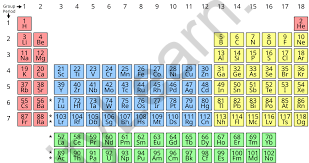Table of Contents
Introduction
As atomic size decreases, nuclear charge increases from La to Lu, leading to lanthanoid contraction. Lanthanide contraction refers to the steady decrease in size that occurs as the atomic number increases. Lanthanide contraction occurs for each of the 14 elements in the lanthanide series. The series includes the elements Gadolinium(Gd), Cerium(Ce), Holmium(Ho), Praseodymium(Pr), Neodymium(Nd), Dysprosium(Dy), Promethium(Pm), Samarium(Sm), Europium(Eu), Terbium(Tb), Erbium(Er), Thulium(Tm), Ytterbium(Yb), and Lutetium(Lu). Atomic radius decreases with increasing atomic number for lanthanide elements.
Lanthanide contraction is the constant reduction in the size of the ions and atoms of the rare earth elements as their atomic numbers increase, from lanthanum (atomic number 57) to lutetium (with an atomic number 71). The nuclear charge can grow by one unit for each successive atom, accompanied by an increase in the electron count in the 4f orbitals around the nucleus.
As the lanthanide elements proceed, the 4f electrons poorly shelter each other from the rising positive charge of the nucleus, resulting in a constant rise in the effective nuclear charge attracting every electron, leading to consecutive decreases in ionic and atomic radii.

Consequences of Lanthanide Contraction’s
The following points will help to clarify the impact of lanthanide contraction:
- Atomic Size
The atom size in the third transition series is generally equivalent to the atom size in the second transition series. The radius of Zr, for instance, equals the radius of Hf, and therefore the radius of Nb equals the radius of Ta, and so on.
- Lanthanide Separating Difficulties
Lanthanides have the same chemical properties because their ionic radii differ just slightly. As a result, separating the element in its pure condition is difficult.
- The Influence of Hydroxides on Basic StrengthThe covalent characteristic of the hydroxides increases as the lanthanide size decreases from La to Lu, and hence their basic strength decreases. As a result, Lu(OH)3 is supposed to be the most basic, whereas La (OH)3 is thought to be the least basic.
- Formation of Complexes
The inclination to create coordinates is due to the smaller size and increased nuclear charge. From the element La3+ to the element Lu3+, the complexity rises.
- Electronegativity
It progresses from the element La to the element Lu.
- Energy of Ionization
Because electrons are more attracted to nuclear charges, the ionization energy of the 5d elements is substantially higher than that of the 4d and 3d elements. Except for Pt and Au, all elements in the 5d series have a filled s-shell.
Elements ranging from Hafnium to Rhenium have equal Ionization energy, and the Ionization energy rises with the number of shared d-electrons, with Gold and Iridium having the highest Ionization Energy.
Lanthanide Contraction’s Cause
Lanthanide contraction occurs as a result of 4f electrons’ inadequate shielding of nuclear charge (via the attractive nuclear force on electrons); 6s electrons can be attracted nearer the nucleus, resulting in a decreased atomic radius.
Atoms with more electrons have smaller radii due to increased nuclear charge, but electrostatic repulsion counteracts this.
Electrons in outer shells experience a weaker nuclear charge due to Shielding Effect. The shielding effect of inner electrons diminishes in the following order: s > p > d > f.
In general, the atomic radius falls when a given subshell is filled in a period. This effect is more prominent in the case of lanthanides since the 4f subshell that is filled throughout these elements is not more efficient at protecting the outer shell electrons (n=5 and n=6). Radius decreases due to increasing nuclear charge, reducing shielding effect.
This results in “lanthanide contraction.” Furthermore, the ionic radius decreases from 103 pm for lanthanum (III) to 86.1 pm for lutetium (III). Up to 10% of the lanthanide contraction has been attributed to relativistic processes.
Shielding Effect on Atomic Radii
The lanthanide is formed due to the 4f electrons’ weak shielding action. Inner shell electrons protect outer shell electrons from nucleus’ charge. As a result, if the shielding effect is poor, the positively charged nucleus attracts the outer shell electron towards itself. The radii of that atom shrink as the positive charge or atomic number increases. As a result, s-shell has a stronger shielding effect than the other subshells, but f-shell has the least shielding effect. The d and p shells are in the middle, with the p-shell providing greater protection than the d-shell.
When we compare the elements with the f-subshell to the d-block elements with no f-subshell in their atom, it becomes evident. Pd and Pt are examples of such elements. Pd has 4d electrons, while Pt has 5d and 4f electrons. As a result, the electronic radii of these two elements were almost the same. This is due to the shielding effect and the contraction of lanthanide. Pt has a bigger radius than Pd because of more electrons and protons, not f-subshell shielding, increasing the nucleus’s pull of electrons.
FAQs
Q. What is the impact on the post-lanthanides?
Ans: The periodic table elements after the lanthanides can be altered by the lanthanide contraction. The period-6 radii transition metals are smaller than would be predicted if no lanthanides were present and are almost identical to the radii of the period-5 transition metals because the impact of the extra electron shell is completely negated by the lanthanide contraction.
Q. What are the causes of lanthanide contraction?
Ans:
- Poor shielding effect of 4f electrons
- Effective nuclear charge increases
- Decrease in size and increase in charge of the nucleus
- Relativistic effects due to high speeds of 4f electrons, leading to contraction of the orbitals.







